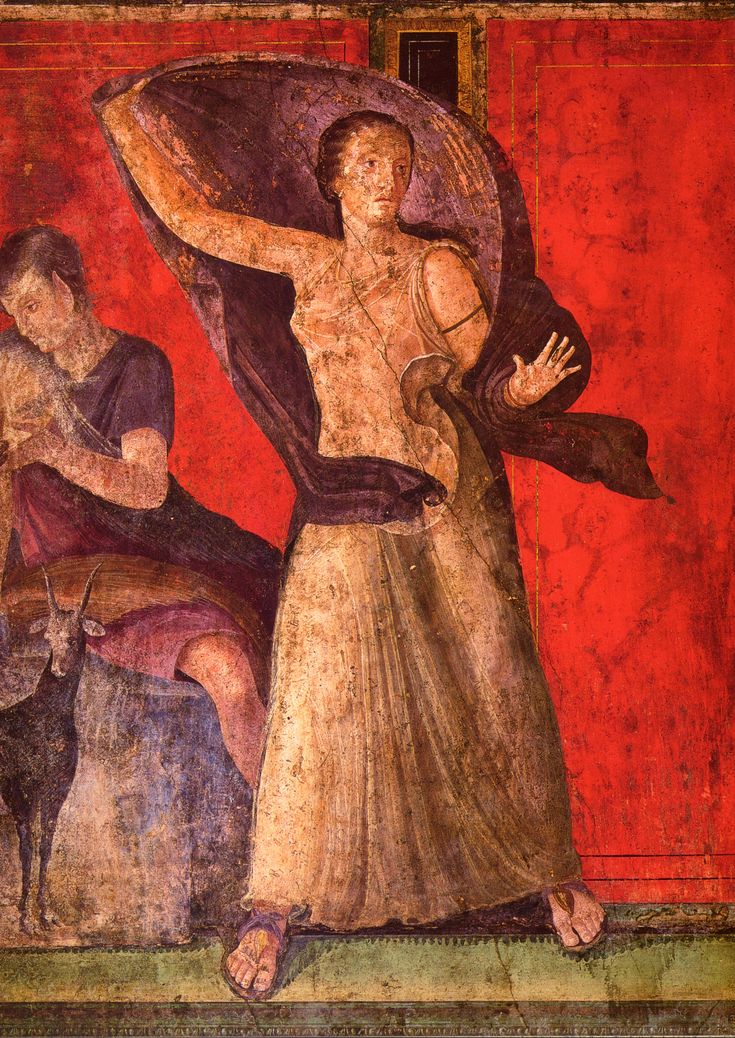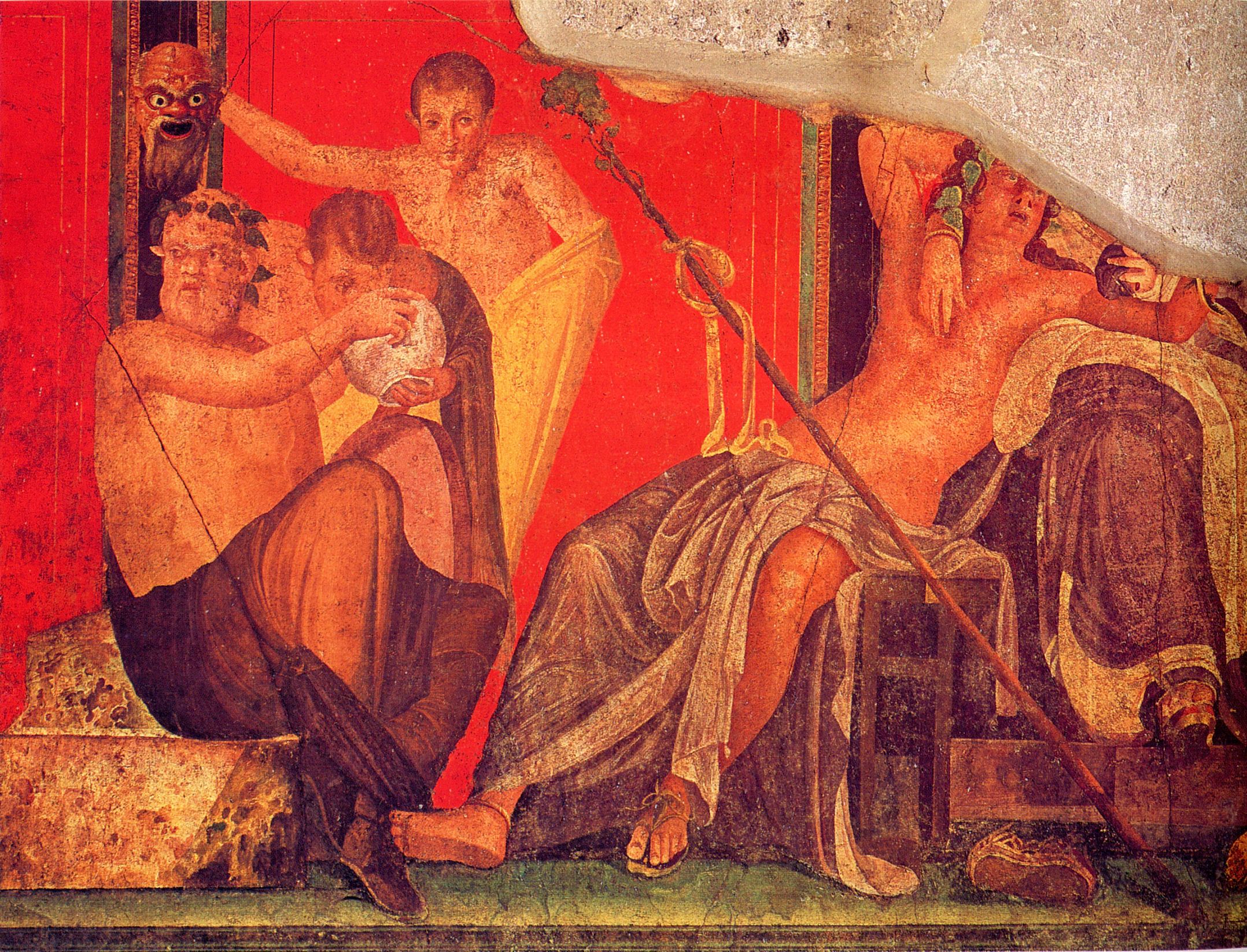Ah, the Villa dei Misteri or the Villa of Mysteries. What could be more exciting than a fresco series depicting Bacchic rituals involving a mystic marriage between a mortal woman and Bacchus?
If the frescos depict the ritual that actually took place, it was quite an event! But the frescos themselves are amazing. Created in the 1st century B.C., they are rare survivals of wall painting – Vesuvius saw to it that so much was destroyed but the ones that weren’t smashed to smithereens were brilliantly preserved by volcanic ash.

The first fresco shows a noble Roman woman entering the space just as we would. She’s demure and wearing a veil but I’m going to say that this is about to change because she’s the initiate about to go through the Bacchic ritual.
As she approaches the lady sitting on throne, perhaps a priestess, a young boy very studiously reads from a scroll. He seems to be being encouraged by the priestess – just look at the way she places her hand around the back of his neck; it’s really tender and very naturalistic. He’s probably reading the declaration of the initiation, and judging by the fact that she has more scroll in her hand, it’s quite long.
This part of the fresco feels very calm. This continues into the next two scenes.

Firstly we have a lady carrying a tray of something or other. No one is quite sure what – perhaps bread or cakes. She’s wearing a crown of myrtle which is associated with Aphrodite the goddess of love, and seems to be carrying some laurel which, in terms of a crown, would signify a triumph or victory but it was also used as seasoning so perhaps she’s the cook rather than a serving girl…
Alternatively she could be the initiate with an offering.
Whoever she is, she’s not engaging with the other figures in the fresco but is interacting with us.
Not so the next group of figures who are absorbed in a shared activity. Again, we aren’t exactly sure what they’re doing but given the girl on the right is pouring water on a purple robe that is being lifted very carefully by the seated women, and assisted by the woman on the right, it might be some kind of cleansing ritual. Whatever is happening, it’s clearly a delicate operation that involves cooperation between the women as the one on the left is looking pretty intently at the one on the right. Notice how the girl to the right is also wearing a myrtle crown.

As is the chap in the following image. In fact that’s all he’s wearing. The purple robe that is being dropped gives some continuity and he’s providing us with a sound track to the narrative as he plays the lyre, lost, I think in his own thoughts. Perhaps that’s how he hasn’t noticed that his robe has fallen off? He may very conceivably also be Silenus, Bacchus’s great friend and teacher; in which case he’s not lost in his own thoughts but completely wasted.
The musical accompaniment continues with a young man or perhaps a satyr playing the panpipes and another suckling goat. This is where it starts to get weird, and this woman knows it!
She’s just to the right of the goat-suckler but actually she’s looking across to the next wall and something is clearly really freaking her out.
Is this the initiate? Is it someone else? We don’t know for sure but we do know that she’d rather hot-foot it out of there. Notice the way that her body is turned in the opposite direction to her face as though she is about to run; it feels as though she might bound off that platform, which looks so real, and escape through the room. Her hand is held out as though to push back what she’s seeing and her face (and upper torso) is brilliantly framed by her billowing cloak which adds to the dynamism of this character. There’s a truly excellent use of light and shadow here which adds a brilliant sense of volume or three dimensionality to this figure; the hand is foreshortened, the way her face is painted brings a sense of her personality and psychology. It’s really accomplished.
OK! But what is it that she’s seen?

She appears to be looking over to the first group of figures on the back wall and perhaps in particular this pretty grim mask that one of the youths is holding up. This is a Silenus mask, used in Bacchic rituals. Silenus (again) proffers a drinking cup to his young friend, but notice how he’s possibly not drinking but looking into the bowl. Notice, too, how the mask lines up with his face so that he can see his reflection and the mask behind him. It reminds me of the gorgon at the bottom of the drinking cup that we saw in the Greek Symposium. This is what you become…

Then we come to the true protagonist in this fresco. A pissed up Bacchus. He’s in the centre of the back wall slouched on Ariadne’s lap, thyrsus propped against his chair; if he’s taking another ‘spiritual’ wife, he’s not going to remember much the next day but that’s how it was with these ceremonies. Remember the maenads? Well, this is what they went through!
It’s probable that the ladies to the right of Bacchus are preparing or unpacking a liknon basket. These were baskets that were used to separate grain from chaff but were also used as cradles and Bacchus was supposed to have been found in one by Silenus, hence they are associated with him. We can see the ubiquitous purple robe again; other things that may have been included in the basket were fruits, a wooden phallus and possibly a Silenus mask. That’s already being bandied about!


The idea is that these objects brought about an awakening and that the initiate would be ushered or perhaps more accurately ‘propelled’ into the retinue of Bacchus…
…which obviously involves a good whipping whilst your sisters comfort you, look on rather sternly or just dance around playing the symbols.
Again, the artist has bridged the corner brilliantly and I’m thinking that whipping is going to hurt by the way she’s pulling back the whip to get a really strong stroke in there.
Rather wonderfully, after this scene, there is a window. It might be fanciful to imagine that this is a metaphorical enlightenment – am I bringing in ideas from the Christian faith where they aren’t appropriate? Anyway, the window creates a gap and the final scene is much calmer again and really rather beautiful.
A cupid figure holds up a mirror to seated woman who is looking out at us whilst another woman, dressed in purple, is, interestingly looking down at the mirror. One of them is probably the initiate but which one? Is the other a new bride being prepared for the ritual to begin again?
So many questions.
What we do know is that these were created by a truly majestic artist and that this would be a place to go back to if you could time travel wearing an invisible cloak to witness some truly interesting scenes!

The video of this episode can be viewed here. To view the entire ‘Elevenses with Lynne’ archive, head to the Free Art Videos page.

Recent Comments